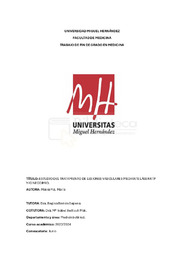Resumen :
Antecedentes: En dermatología, un gran número de patologías son tratadas con láser, entre ellas las patologías vasculares. Para ello generalmente se emplea el láser de colorante pulsado (PDL), así como el láser Nd: YAG y el láser KTP. A pesar de ello no hay muchos estudios acerca de este último ni de su combinación con el láser Nd:YAG.
Objetivo: evaluar los resultados del uso del láser KTP y/o Nd:YAG en el tratamiento de patologías vasculares cutáneas.
Material y métodos: Estudio descriptivo retrospectivo. Incluyendo a todos los pacientes con patologías vasculares de la consulta de láser del servicio de Dermatología del HGUA, desde septiembre de 2017 hasta marzo de 2023. Se evaluaron variables epidemiológicas, clínicas, de los parámetros láser, la evolución favorable o desfavorable de las lesiones y los efectos adversos observados.
Resultados: Se analizaron los datos de 76 pacientes. La edad media de tratamiento fue de 38,37 años, siendo la mayoría mujeres (69,7%). Las lesiones más frecuentes fueron las telangiectasias (28,9%). El tipo de láser más utilizado fue el Nd:YAG (42,1%) y el número medio de sesiones fue de 2,5, requiriendo en un 67,1% de casos 2 sesiones o menos. La evolución fue favorable en el 88,2% de los casos y aparecieron efectos adversos en un 10,5%. No se encontraron diferencias significativas entre los parámetros de inicio y final de los láseres. Sí que se encontraron diferencias (p.032) en el uso del láser KTP en la rosácea respecto a los otros tipos. En el grupo pediátrico el láser KTP fue el más empleado y la patología más frecuente las malformaciones capilares.
Conclusiones: El láser KTP y el Nd:YAG, y su uso combinado son buenas opciones para tratas patologías vasculares, con buenos resultados y escasos efectos adversos.
Background: In dermatology a large number of pathologies are treated with lasers, including vascular pathologies. For this, the pulsed dye laser (PDL) is generally used, as well as the Nd:YAG laser and the KTP laser. However, there are not many studies about the KTP laser or its combination with the Nd:YAG laser.
Objective: Evaluate the results of the use of the KTP laser and /or Nd:YAG laser in the treatment of vascular pathologies.
Material and methods: Retrospective descirptive study. Including all the patients with vascular lesions treated in the Dermatology service of the HGUA, from Septembre 2017 to March 2023. Epidemiological, clinical and laser variables were studied, as well as the evolution of the lesions and the observed adverse effects.
Results: Data from 76 patients were analyzed. The mean age was 38,37 years, with the majority of the patients being women (69,7%). The most frequent lesions were telangiectasias (28,9%). The most used laser was Nd:YAG (42,1%) and the average number of sessions was 2.5, with 67,1% requiring 2 sessions or les. The evolution was favorable in 88,2% of cases and adverse effects appeared in 10,5%. No significant differencies were found when coparing the start and end parametres of laser. Differences were found (p.032) in the use of KTP laser in rosacea compared to the other types. In the pediatric group, the KTP laser was the most used and the most common pathology was infantile hemangiomas.
Conclusions: The KTP and Nd:YAG lasers, as well as their combination, are good treatment options for vascular pathologies, generally presenting good results and few adverse effects appearing
|
 La licencia se describe como: Atribución-NonComercial-NoDerivada 4.0 Internacional.
La licencia se describe como: Atribución-NonComercial-NoDerivada 4.0 Internacional.
.png)
